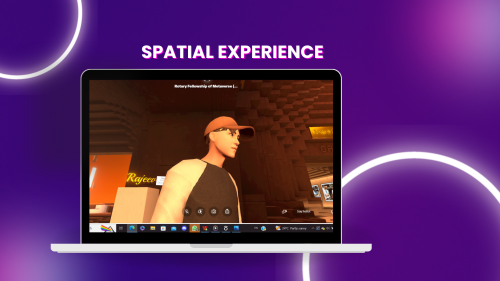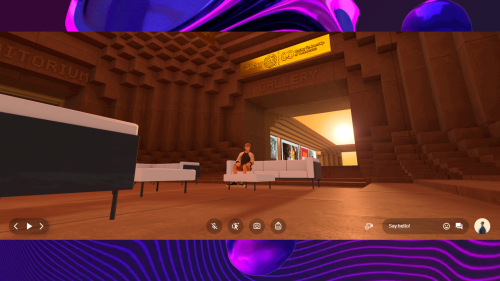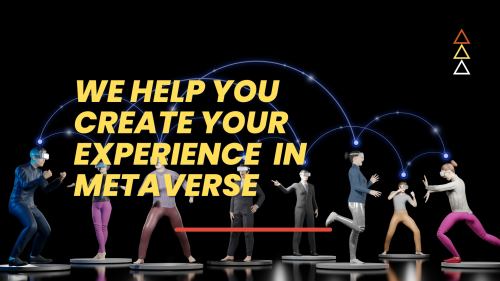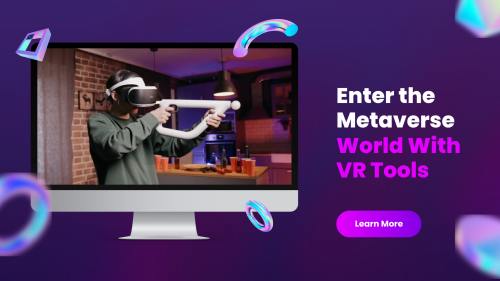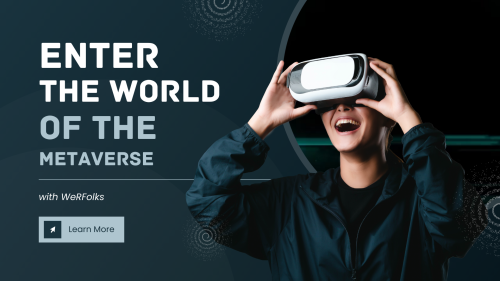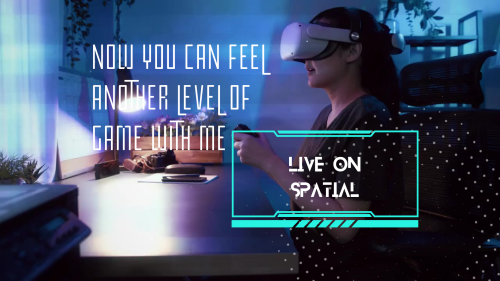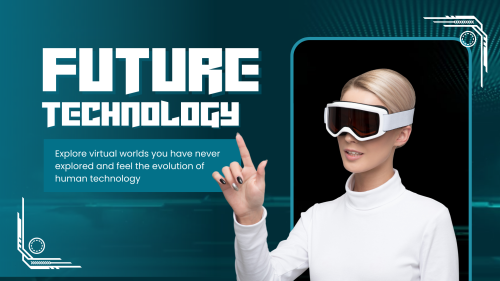Feel how the space on Spatial looks like.
To consult an expert, please write to swapna@werfolks.com
Experience the a walk in a space created on Spatial.io.
To consult an expert, please write to swapna@werfolks.com
The metaverse is an opportunity for creators, their supporters, and their fans to interact more closely than ever before. The experience built on metaverse is a new mode to connect with your stakeholders.
We can help you create your own metaverse experience on platforms that enable this.
Contact us to consult an expert, write to swapna@werfolks.com
Introduction
The concept of the metaverse, a virtual universe where people can interact with each other and experience immersive digital environments, has long captured the imagination of science fiction enthusiasts. However, recent advancements in virtual reality (VR) technology have brought us closer than ever to realizing this dream. With powerful VR tools at our disposal, we now have the ability to enter the metaverse and explore a world of limitless possibilities. In this article, we will explore how VR tools are transforming our journey into the metaverse and the exciting potential that lies ahead.
Immersive VR Experiences
Virtual reality offers an unparalleled level of immersion, transporting users to entirely new worlds. By combining high-resolution displays, motion tracking, and realistic audio, VR tools create an environment that tricks our senses into believing we are physically present in a virtual space. This heightened sense of immersion is a crucial component in enabling us to enter the metaverse and engage with its digital landscapes.
Social Interactions and Connectivity
One of the defining features of the metaverse is its social nature. VR tools play a pivotal role in enabling users to connect with each other in this virtual realm. With the ability to represent ourselves through avatars, we can interact with friends, family, and even strangers, fostering meaningful connections and shared experiences. Virtual meeting spaces, virtual marketplaces, and multiplayer games within the metaverse are just a few examples of how VR tools enhance social interactions and create a sense of community.
Creation and Personalization
The metaverse is not just a space to explore but also a canvas for creativity. VR tools empower users to create and personalize their own virtual experiences within this vast digital landscape. With intuitive tools for 3D modeling, animation, and world-building, individuals can design unique virtual environments and objects. This opens up possibilities for virtual art galleries, virtual concerts, and even virtual businesses. The metaverse becomes a platform for self-expression, where people can showcase their talents and share their creations with others.
Cross-Platform Accessibility
VR tools are becoming increasingly accessible across various platforms, making the entry into the metaverse more inclusive. While dedicated VR headsets offer the most immersive experiences, advancements in mobile VR and augmented reality (AR) technologies enable users to engage with the metaverse through their smartphones or AR glasses. This broader accessibility ensures that the metaverse is not limited to a select few but can be experienced by a wider audience.
Opportunities and Challenges
Entering the metaverse with VR tools presents both opportunities and challenges. On one hand, the metaverse has the potential to revolutionize various industries such as gaming, entertainment, education, and commerce. It can create new avenues for innovation, collaboration, and economic growth. On the other hand, there are concerns related to privacy, security, and the potential for further societal divisions. As we navigate this new frontier, it is crucial to address these challenges proactively and ensure that the metaverse remains a safe and inclusive space for everyone.
Conclusion
VR tools are instrumental in enabling us to enter the metaverse, unlocking a realm of immersive experiences, social interactions, and creative opportunities. As technology continues to advance, the metaverse will become an integral part of our digital lives, offering a seamless blend of virtual and physical realities. While there are challenges to overcome, the possibilities presented by the metaverse are truly exciting. It is up to us to shape this virtual universe responsibly and ensure that it enriches our lives in meaningful ways.
Contact us to consult an expert, write to swapna@werfolks.com
Spatial is a platform for creators and brands build their own spaces in the metaverse to share culture together. It empowers you to leverage their beautiful spaces to share eye popping content, build a tight knit community, and drive meaningful sales of creative works and products. It also empower you to create beautiful and functional 3D spaces that you can mint as NFTs and sell/rent to others looking to host mind blowing experiences.
WeRFolks can help you start with Spatial create your own experience on the plaform and sustain it.
Contact us to consult an expert, write to swapna@werfolks.com
Introduction
Virtual reality (VR) has transformed the way we experience digital content, providing immersive and interactive environments. One groundbreaking platform that takes VR to new heights is Spatial.io. Combining VR technology with collaborative tools, Spatial.io offers a unique and powerful solution for remote collaboration, communication, and productivity. In this article, we will explore the capabilities and potential of Spatial.io in revolutionizing the way we work, connect, and interact in virtual reality.
Immersive Collaboration
Spatial.io provides a shared virtual workspace where users can collaborate and interact in real time. By utilizing VR headsets, participants can join a virtual room and communicate with each other through voice chat and gestures. This immersive environment breaks down geographical barriers and allows for seamless collaboration regardless of physical location. With Spatial.io, teams can collaborate on projects, brainstorm ideas, and visualize concepts together, leading to enhanced creativity and productivity.
Spatial Computing and Object Interaction
One of the key features of Spatial.io is spatial computing, which enables users to interact with digital objects and information in a physical space. Through hand tracking or controllers, users can manipulate objects, move them around, resize them, and even annotate them. This capability transforms virtual collaboration into a dynamic and intuitive experience, where participants can interact with 3D models, visualizations, and multimedia content. Spatial.io empowers users to work with data and information in a way that feels natural and intuitive.
Enhanced Communication and Presence
Spatial.io leverages VR technology to enhance communication and presence among remote collaborators. Participants in a virtual room can see avatars representing each other, complete with gestures and body language, creating a more natural and engaging communication experience. This sense of presence makes virtual meetings and interactions feel more authentic, fostering better understanding and connection among team members. Spatial.io also supports the integration of video conferencing platforms, allowing users to seamlessly combine virtual and real-world communication channels.
Multiuser Collaboration and Integration
Spatial.io excels in supporting multiuser collaboration, enabling multiple participants to work together in the same virtual space simultaneously. Whether it's designing 3D models, reviewing architectural plans, or conducting virtual training sessions, Spatial.io provides a platform where teams can work together in real time, regardless of their physical locations. Furthermore, Spatial.io integrates with popular productivity tools like Google Drive, Trello, and Slack, enhancing workflow efficiency and enabling seamless transitions between virtual and real-world workflows.
Future Potential and Applications
The potential applications of Spatial.io are vast and varied. Beyond team collaboration, Spatial.io can be utilized in areas such as education, remote training, virtual conferences, and virtual events. With the continued advancement of VR technology and the growing adoption of Spatial.io, we can expect to see new and innovative use cases emerge in fields like architecture, engineering, design, and healthcare. Spatial.io has the potential to redefine how we interact, communicate, and collaborate in virtual environments, opening up exciting possibilities for the future of work and social interaction.
Conclusion
Spatial.io represents a significant leap forward in virtual reality collaboration, offering a platform that enhances immersion, communication, and productivity. By combining VR technology with collaborative tools, Spatial.io enables teams to collaborate, visualize ideas, and work together in a shared virtual space. As this technology continues to evolve, we can expect Spatial.io to play a pivotal role in shaping the future of remote collaboration, transforming the way we connect, innovate, and create in virtual reality.
To consult an expert, write to swapna@werfolks.com
We help you go Live on Spatial. Get your spatial experience with us. Connect with the world live.
Contact us to consult an expert, write to swapna@werfolks.com
Introduction
The advent of the metaverse has brought about a paradigm shift in the way we interact and connect with others in the digital realm. In this new virtual universe, social networking sites play a vital role in bridging the gap between physical and digital realities. They provide platforms for users to engage, communicate, and build communities within the metaverse. In this article, we will explore the evolving landscape of social networking sites in the metaverse and their impact on our social interactions.
Creating Digital Identities
Social networking sites have long been associated with the creation of digital identities. In the metaverse, these platforms take this concept to a whole new level. Users can create avatars that represent them in the virtual space, allowing for a more immersive and personalized social experience. These digital identities can be customized, reflecting users' preferences, personalities, and even physical appearances. Social networking sites in the metaverse enable users to curate their virtual personas and connect with others based on shared interests and experiences.
Enhancing Social Interactions
Social networking sites within the metaverse serve as hubs for social interactions, fostering connections between users from around the globe. Through real-time voice and text chat, users can engage in conversations, share experiences, and form meaningful relationships. These platforms facilitate both one-on-one interactions and group collaborations, enabling users to collaborate on projects, participate in virtual events, and even attend virtual parties. The metaverse provides a rich and interactive social environment that transcends physical boundaries.
Building Communities and Virtual Spaces
One of the key aspects of social networking sites in the metaverse is the ability to build and join communities. Users can create or join virtual communities centered around specific interests, hobbies, or professions. These communities serve as gathering places for like-minded individuals to share knowledge, collaborate on projects, and organize events. Social networking sites in the metaverse also enable users to create and personalize their virtual spaces, such as virtual homes, art galleries, or performance venues. These spaces become meeting points for community members, fostering a sense of belonging and shared experiences.
Integration with Real-World Networks
Social networking sites in the metaverse have the potential to bridge the gap between the virtual and physical worlds. They offer integration with real-world networks, allowing users to connect with their existing social circles. For example, users can import their contacts from traditional social media platforms, inviting friends and family to join them in the metaverse. This integration ensures that users can continue to nurture their real-world relationships while exploring the vast possibilities of the metaverse.
Privacy and Ethical Considerations
As social networking sites in the metaverse become more prevalent, it is crucial to address privacy and ethical considerations. The metaverse presents unique challenges in terms of data privacy, virtual identity management, and security. It is essential for these platforms to prioritize user privacy and provide robust measures to protect personal information. Additionally, ethical guidelines must be established to ensure a safe and inclusive social environment within the metaverse.
Conclusion
Social networking sites within the metaverse are redefining the way we connect, interact, and build communities in the digital realm. They offer users the opportunity to create digital identities, engage in immersive social interactions, and build meaningful relationships. As the metaverse continues to evolve, social networking platforms will play a pivotal role in shaping the social fabric of this virtual universe. It is crucial to embrace these platforms responsibly, fostering inclusivity, privacy, and ethical practices to create a metaverse that enriches our social lives while respecting individual rights and values.
Contact us to consult an expert, write to swapna@werfolks.com

